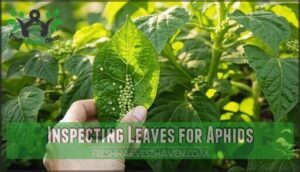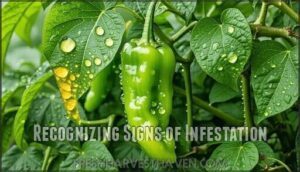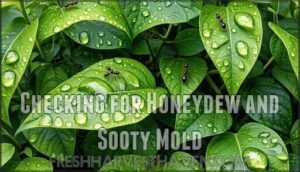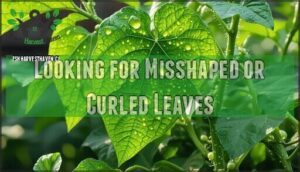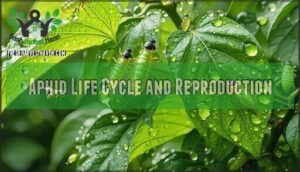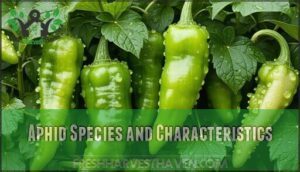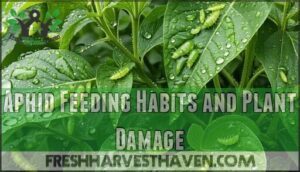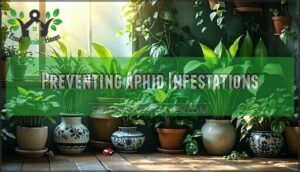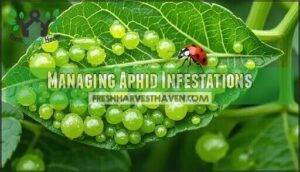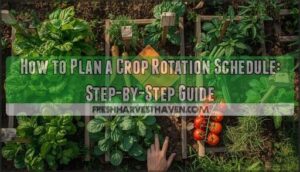This site is supported by our readers. We may earn a commission, at no cost to you, if you purchase through links.
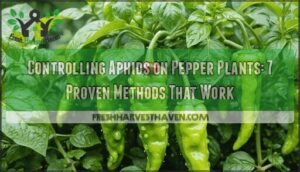
Start by hosing off visible aphids with a strong water spray, then apply insecticidal soap or neem oil to remaining pests.
Introduce beneficial insects like ladybugs and lacewings to establish natural predation.
Plant companion herbs like basil and cilantro to repel aphids naturally.
Remove weeds and debris that harbor overwintering aphids, and avoid over-fertilizing with nitrogen, which creates tender growth that attracts these pests.
Regular inspection helps you catch infestations before they explode into colony-damaging numbers that can stunt your pepper harvest.
Table Of Contents
- Key Takeaways
- Identifying Aphid Damage
- Aphid Biology and Behavior
- Natural Control Methods
- Chemical and Organic Treatments
- Preventing Aphid Infestations
- Managing Aphid Infestations
- Frequently Asked Questions (FAQs)
- How do you get rid of aphids on pepper plants?
- Do pepper plants get aphids?
- Does pepper spray kill aphids?
- Do pepper plants repel aphids?
- Does vinegar kill aphids on pepper plants?
- How do you spot aphids on pepper plants?
- What environmental conditions encourage aphid infestations?
- How do aphids overwinter on pepper plants?
- Can aphids develop pesticide resistance over time?
- What attracts ants to aphid-infested pepper plants?
- Conclusion
Key Takeaways
- Act quickly when you spot aphids – Use strong water sprays to dislodge them immediately, then apply insecticidal soap or neem oil to prevent colonies from establishing and overwhelming your plants.
- Introduce beneficial insects for natural control – Release ladybugs and lacewings that can consume 50-100+ aphids daily, providing long-term population management without chemicals.
- Plant companion herbs and flowers – Grow basil, cilantro, and marigolds near your peppers to naturally repel aphids while attracting predatory insects that keep pest populations in check.
- Prevent infestations through garden hygiene – Remove weeds and debris that harbor overwintering aphids, avoid over-fertilizing with nitrogen, and inspect plants weekly to catch problems before they explode.
Identifying Aphid Damage
You can spot aphid damage on pepper plants by checking the undersides of leaves for small, soft-bodied insects that cluster together and leave behind sticky honeydew residue.
Look for telltale signs like curled or yellowing leaves, small dark spots along leaf veins, and deformed peppers that signal these sap-sucking pests have taken hold.
Inspecting Leaves for Aphids
Start by checking the leaf undersides where aphids love to hide.
Hold pepper plant leaves up to sunlight to spot aphid shadows through the foliage. Focus your plant inspection on new growth since aphids target tender, young leaves first.
Green camouflage makes green peach aphids nearly invisible, so look carefully for movement or clustered insects. Early detection prevents minor problems from becoming major aphid infestations requiring intensive aphid control measures.
Attracting ladybugs helps with aphid population control.
Recognizing Signs of Infestation
Several telltale signs reveal aphid infestations on pepper plants.
Leaf discoloration appears as yellowing or browning spots where aphids extract sap.
You’ll notice sticky honeydew coating stems and leaves, often accompanied by ant activity as they harvest this sweet substance.
Deformed peppers develop from prolonged feeding damage.
Sooty mold creates black patches on honeydew-covered surfaces, blocking photosynthesis and signaling established aphid colonies requiring immediate intervention.
Checking for Honeydew and Sooty Mold
Honeydew appears as a sticky, clear substance on pepper plant stems and leaves.
This sugary secretion attracts ants and provides the perfect growing medium for sooty mold.
The black fungal coating blocks sunlight, reducing photosynthesis and weakening your plants.
Secondary infections often follow when honeydew creates favorable conditions for harmful bacteria.
- Honeydew Identification: Look for shiny, sticky residue on stems and leaf surfaces where pepper aphids have been feeding
- Sooty Mold Impact: Check for dark, powdery coating that reduces light absorption and stunts plant growth
- Ant Attraction: Notice increased ant activity around affected areas, as they farm aphids for their sweet honeydew production
Looking for Misshaped or Curled Leaves
Deformed leaves tell the story of aphid damage before colonies become visible.
You’ll notice pepper plant leaves curling inward, twisting unnaturally, or developing yellow patches where pepper aphids feed.
Early detection through visual inspection helps you spot these plant health changes, even when aphid camouflage makes the pests hard to see during aphid infestation.
| Leaf Damage Type | What You’ll See | Aphid Activity Level |
|---|---|---|
| Slight curling | Edges curl under slightly | Early infestation |
| Moderate twisting | Leaves twist and wrinkle | Active feeding |
| Severe deformation | Heavy curling, yellow spots | Heavy infestation |
| Stunted growth | New leaves stay small | Chronic pepper plant pests |
Aphid Biology and Behavior
Understanding aphid biology helps you target these pests more effectively when they attack your pepper plants.
Most aphids are born pregnant and reproduce rapidly, creating colonies that can damage your plants within days if left unchecked.
Aphid Life Cycle and Reproduction
Most aphids are born pregnant, making them reproduction champions.
This asexual reproduction creates rapid growth that can overwhelm your pepper plants in days. Understanding their life cycle helps you time treatments effectively.
Here’s how aphid reproduction works:
- Aphid Birth – Female aphids give birth to live clones without mating
- Asexual Reproduction – Each clone matures in 7-10 days and starts reproducing
- Winged Aphids – Crowded colonies produce winged forms that spread to new plants
- Overwintering Eggs – Cold triggers sexual reproduction, creating hardy eggs for spring
Aphid Species and Characteristics
Which aphid species poses the greatest threat to your pepper plants? Green peach aphids dominate pepper infestations, displaying light green to pink Aphid Coloration and measuring 1.5-2.0 mm long.
Their Aphid Morphology includes soft, pear-shaped bodies with long antennae. Potato aphids appear green or pink, while melon aphids show variable appearances.
Winged Aphids develop during overcrowding, enabling rapid spread between pepper plants and increasing aphid infestation risks.
Aphid Feeding Habits and Plant Damage
Plant feeding by these pests causes serious damage through sap extraction from pepper plant tissues.
This process weakens plants and creates sticky honeydew that attracts ants and promotes sooty mold growth.
Disease transmission occurs when aphids move between plants, spreading viruses like cucumber mosaic. The result is stunted growth and significant yield reduction in your pepper crop.
Natural Control Methods
Natural pest control methods protect your pepper plants without harsh chemicals that might harm beneficial insects.
You can use water sprays, attract helpful predators, and create physical barriers to manage aphid populations effectively, which is a key part of natural pest control.
Using Water to Remove Aphids
High-pressure water spray effectively dislodges aphids from pepper plants without chemicals.
Use your garden hose on maximum water pressure, targeting leaf undersides where aphids cluster.
Spray frequency should be daily until the aphid infestation clears completely.
You can find an aphid hose attachment online.
Best timing is early morning when temperatures are cooler, preventing leaf damage from hot sun exposure after treatment.
Introducing Beneficial Insects
Releasing nature’s army against aphids transforms your pepper garden into a battlefield where good bugs win. Lady beetles consume up to 50 aphids daily, while green lacewing larvae devour 100+ pests per day. Parasitic wasps kill aphids within days by laying eggs inside them.
You can find live ladybugs for sale to help combat aphid infestations.
- Ladybug introduction works best when aphid populations are low – timing is everything for maximum impact
- Lacewing benefits include their voracious appetite and ability to reduce infestations in 5-10 days naturally
- Parasitic wasps like Aphidius colemani provide long-term control by targeting aphid reproduction cycles directly
Planting Companion Flowers and Herbs
Why not turn your garden into a natural fortress against aphids? Smart companion planting creates a living defense system that works around the clock.
Plant alyssum near your peppers to attract ladybugs and lacewings. These predator magnets boost beneficial insect populations substantially.
| Attracting Predators | Repelling Aphids |
|---|---|
| Alyssum draws ladybugs | Marigold deters pests |
| Dill attracts lacewings | Chives repel aphids |
| Fennel brings parasitic wasps | Catnip confuses insects |
| Yarrow supports beneficial bugs | Garlic creates barriers |
Herb benefits extend beyond pest control. Chives and garlic naturally repel aphids while enhancing soil health. Marigold releases compounds that confuse aphid navigation systems.
Flower selection matters – choose varieties that bloom throughout the growing season for continuous protection.
Using Row Covers and Reflective Mulches
Row covers act as a physical barrier during early pepper growth stages, preventing aphid colonization by blocking their access to plants.
These floating row materials reduce infection rates substantially compared to exposed plants.
Reflective mulches, particularly silver-colored options, decrease aphid landings by 50-70% versus bare soil.
The mulch color impact confuses aphids’ visual navigation systems.
Installation best practices include securing covers tightly and removing them during flowering for pollination.
Chemical and Organic Treatments
When natural methods aren’t enough, you’ll need stronger treatments to eliminate stubborn aphid colonies on your pepper plants.
Chemical and organic options can quickly reduce aphid populations while protecting your harvest from serious damage.
Insecticidal Soap and Neem Oil
For organic aphid control on pepper plants, insecticidal soap offers immediate knockdown power through cell membrane disruption.
Apply during cool conditions to prevent leaf burn. Neem oil disrupts reproduction cycles, requiring patience for effectiveness.
DIY recipes work well: mix dish soap with water for instant results. Treatment timing matters—evening applications protect beneficial insects.
One can also introduce ladybugs for aphid control in the garden. Resistance concerns remain minimal with these organic methods.
Diatomaceous Earth and Essential Oils
Diatomaceous earth works by dehydrating aphids through sharp particles that destroy their waxy outer layer.
Apply food-grade DE during calm conditions to avoid drift. Essential oils like peppermint, clove, rosemary, and thyme repel aphids effectively. Mix 10-15 drops per cup of water for DIY recipes.
Safety concerns include potential harm to beneficial insects, so target application carefully. You can find various DE products online.
Treatment timing matters—apply during evening hours to prevent plant damage from sunlight interaction, using treatment timing as a critical factor.
Systemic Pesticides and DIY Solutions
Two powerful aphid treatment options offer different approaches for pepper plants.
Imidacloprid concerns center on pollinator safety, making systemic pesticides controversial despite their 90% mortality rates within a week.
Soap effectiveness reaches 60-70% knockdown when applied correctly.
Neem application disrupts reproduction while DE hazards include harm to beneficial insects.
DIY safety requires proper dilution ratios for homemade aphid spray solutions on pepper plants to ensure proper dilution.
Applying Treatments Safely and Effectively
Safe application timing matters when treating aphids on pepper plants.
Apply insecticidal soap or neem oil during evening treatments to prevent leaf burn from sunlight.
Follow proper dilution ratios to avoid plant damage while ensuring effective pest control.
- Cover all surfaces – Spray both upper and lower leaf surfaces for complete foliage coverage
- Time it right – Evening applications protect plants and maximize aphid contact time
- Stay consistent – Maintain reapplication frequency every 5-7 days until aphid populations drop
Preventing Aphid Infestations
Prevention keeps aphids away from your pepper plants before they become a problem.
You’ll save time and protect your harvest by taking simple steps that stop these pests from settling in.
Inspecting Plants Regularly
Why wait until aphids overwhelm your pepper plants?
Early detection through regular intervals of garden inspection stops infestations before they start. Conduct thorough examination weekly, focusing on identifying hotspots where aphids cluster.
Check undersides of new leaves against light, monitoring for small shadows or dark spots along veins. This preventative measures approach catches problems early, making aphid infestation management much easier than battling established colonies, by using regular intervals of inspection.
Removing Weeds and Debris
Keep your pepper garden clean by removing weeds like purslane and pigweed, which serve as aphid reservoirs and increase infestation chances by 35%.
Clear fallen leaves and plant debris that harbor overwintering aphids.
Good sanitation practices and weed identification improve soil health while supporting effective pest prevention strategies. These garden pest prevention techniques create an environment where beneficial insects thrive.
Avoiding Overwatering and Fertilizing
Balanced watering and fertilizing practices create healthier pepper plants that resist aphid attacks. Overwatering creates root rot conditions, while excess nitrogen-rich fertilizer produces tender growth that attracts these pests.
One key element is proper watering practices to avoid fungal issues.
Follow these watering frequency guidelines:
- Check soil moisture 2 inches deep before watering pepper plants
- Water deeply but infrequently to prevent nutrient imbalance issues
- Apply balanced fertilizer types monthly rather than weekly nitrogen doses
Proper soil health management strengthens plant defenses against aphid infestations naturally.
Using Physical Barriers and Traps
Physical barriers create a fortress around your pepper plants that aphids can’t breach.
Sticky traps catch flying aphids before they land and establish colonies. Row covers and barrier fabrics block access during vulnerable growth stages.
Plant sleeves protect individual stems from crawling pests. Copper tape around containers deters aphids through electrical conductivity.
Trap crops like nasturtiums lure aphids away from your peppers, using sticky traps and copper tape to protect the plants.
Managing Aphid Infestations
Once you spot aphids on your pepper plants, quick action prevents them from multiplying into a major problem.
These management strategies target existing infestations using both gentle and more aggressive approaches depending on the severity.
Hand Removal and Pruning
Hand removal offers the most precise control when dealing with small aphid colonies on pepper plants.
This old-school approach works best during early detection phases before infestation severity escalates beyond manageable levels.
- Crushing aphids between your fingers gives instant satisfaction while protecting beneficial insects
- Pruning techniques remove heavily infested leaves, preventing spread to healthy plant tissue
- Leaf sanitation through selective removal eliminates honeydew buildup and disease transmission risks
Target clusters on leaf undersides where pests congregate.
Remove damaged foliage immediately to prevent recolonization.
This method’s effectiveness depends on catching infestations early.
Washing Plants With Water
Strong water pressure from your hose effectively removes aphids from pepper plants without chemicals.
Use moderate spray frequency—daily treatments work best until colonies disappear.
Aim for lukewarm water temperature to avoid leaf damage from hot or cold extremes.
Best timing occurs during early morning or evening hours when plants handle moisture better.
Direct the water spray underneath leaves where aphids cluster most heavily.
Applying Natural Remedies and Insecticidal Soap
Several natural remedies and insecticidal soap offer effective natural aphid control without harsh chemicals.
These homemade aphid spray solutions work by disrupting aphid cell membranes on contact.
Safe Treatment Practices:
- DIY Soap Recipes – Mix 1-2 tablespoons Dawn dish soap per gallon of water for effective insecticidal soap
- Neem Oil Benefits – Apply neem oil during cool conditions to prevent leaf burn while stopping aphid reproduction
- Natural Remedy Timing – Spray during evening hours to avoid plant damage from sunlight
- Soap Application Tips – Coat both leaf surfaces until dripping wet for thorough coverage
- Controlling Aphids – Reapply treatments every few days following label instructions for best results
Introducing Beneficial Insects and Monitoring Progress
Release beneficial insects like ladybugs and green lacewing larvae when you first spot aphids.
These predators can eliminate up to 90% of aphid populations within three weeks.
Monitor your pepper plants every 2-3 days using yellow sticky traps to track both pest and predator numbers.
Check for aphid mummies and reduced colony formation as signs of successful predator introduction.
Planting marigolds has advantages in repelling aphids and attracting natural predators.
Frequently Asked Questions (FAQs)
How do you get rid of aphids on pepper plants?
Spray aphids off with strong water, apply insecticidal soap or neem oil, introduce ladybugs and lacewings, or hand-pick small infestations for effective control.
Do pepper plants get aphids?
Yes, pepper plants frequently get aphids.
These small, soft-bodied insects commonly infest pepper plants by clustering on leaf undersides and stems, sucking plant sap and causing yellowing leaves and stunted growth.
Does pepper spray kill aphids?
Don’t put all your eggs in one basket—pepper spray won’t kill aphids effectively. You’ll need insecticidal soap, neem oil, or water spraying to control these soft-bodied pests properly.
Do pepper plants repel aphids?
Pepper plants don’t naturally repel aphids. These soft-bodied insects actually target pepper plants as preferred hosts, feeding on their sap and causing damage despite the plant’s spicy compounds.
Does vinegar kill aphids on pepper plants?
Vinegar can kill aphids through its acidic properties, but it’s not the most effective solution. You’ll need a strong concentration that might damage your pepper plants’ leaves and stems.
How do you spot aphids on pepper plants?
Look underneath newly formed leaves where soft, pear-shaped insects cluster.
Check for small dark spots along leaf veins and sticky honeydew residue on stems.
Green aphids camouflage easily against pepper foliage.
What environmental conditions encourage aphid infestations?
Warm, humid weather creates ideal breeding conditions for aphids. You’ll notice more infestations during spring and early summer when temperatures stay between 60-80°F with high humidity levels.
How do aphids overwinter on pepper plants?
Consider this nightmare scenario: You’re carefully pruning your overwintered pepper plants when you discover tiny green clusters hiding beneath the leaves.
Aphids overwinter as extremely cold-hardy eggs that can survive freezing temperatures down to -36°C.
Most aphids survive winter as eggs, making them resilient through harsh seasons.
These eggs are often laid in the bud axils of woody hosts, which is a critical aspect of their life cycle.
Can aphids develop pesticide resistance over time?
Yes, aphids can develop pesticide resistance over time.
Studies show over 40% of green peach aphid populations resist pyrethroids in treated North American fields, making rotation between different chemical classes essential for effective control.
What attracts ants to aphid-infested pepper plants?
Ants feast on honeydew.
Ants harvest sticky residue, ants protect aphid colonies.
You’ll find ants farming aphids like tiny livestock, collecting the sweet honeydew waste aphids excrete while feeding on your pepper plants’ sap.
Conclusion
Successfully controlling aphids on pepper plants requires patience, like training a stubborn pet to behave.
You’ve learned multiple approaches, from natural predators to chemical treatments, each targeting different aspects of aphid behavior.
The key isn’t choosing one perfect method, but combining strategies that work for your specific garden conditions.
Regular monitoring remains your best defense against future infestations.
With consistent application of these proven techniques, you’ll maintain healthy pepper plants and maximize your harvest potential.

